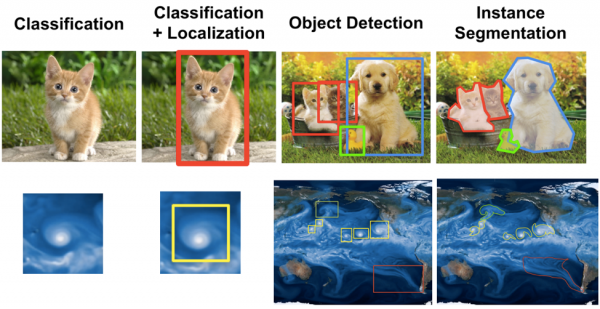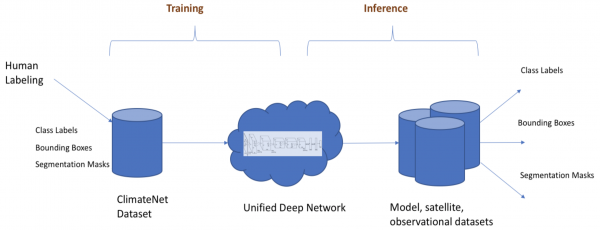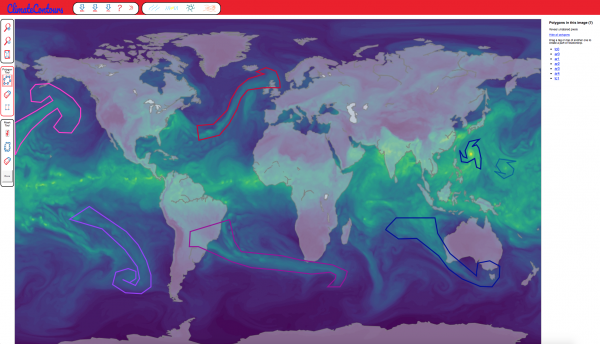ClimateNet
Bringing the power of Deep Learning to the climate community via open datasets and architectures
Mission
The ClimateNet Project seeks to address a major open challenge in bringing the power of deep learning to the climate community, viz. creating community-sourced open-access expert-labeled datasets and architectures for improved accuracy and performance on a range of supervised learning problems, where plentiful reliable labeled training data is a requirement.
Motivation
Pattern recognition tasks such as classification, localization, object detection, and segmentation have remained challenging problems in the weather and climate sciences (see figure below for analogs between classic computer vision tasks and corresponding climate science tasks).

While there exist many heuristics and algorithms for detecting weather patterns or extreme events in a dataset, the disparities between the output of these different methods, even for a single class of event, are huge and often impossible to reconcile. See, for example, the ARTMIP project that attempts to compare, contrast and reconcile the dozen or so atmospheric river tracking algorithms.
Meanwhile, Machine Learning and Deep Learning based approaches for pattern recognition and pattern discovery tasks are showing great promise across the sciences. However, for supervised ML and DL methods, the availability of plentiful reliable training data is key. Given the scarcity of reliable labeled training data for supervised Deep Learning based approaches and the pressing need to address this problem, we propose creating a community-sourced expert-labeled database.
Vision and Proposed Approach
The figure below captures our overall vision for a unified Deep Learning workflow relevant to climate science. The workflow can be split into two pieces: the training phase and the inference phase. The goal of the training phase is to produce a single, unified deep network that is trained by examples from “hand”-labeled examples by human experts. In the inference phase, the unified deep network is applied to archives of multi-resolution, multimodal datasets from climate model output or reanalyses or observational datasets.

A fundamental challenge in training Deep Networks is the availability of reliable, suitably labeled training data. We propose creating a “ClimateNet” dataset, with an accompanying schema that can capture information pertaining to pattern labels, bounding boxes, and segmentation masks. Domain experts (atmospheric and climate scientists) contribute "hand"-labeled information to the ClimateNet dataset – the proposal was first presented by Prabhat, Karthik Kashinath et al. at AGU 2017, and a project update was presented at AGU 2018.
We have developed a web interface called ClimateContours based on the “Label-Me” tool developed at the MIT computer vision lab to crowdsource the `hand'-labeling task. Note that the overall spirit of the Deep Learning methodology is to avoid the prescription of heuristics for defining weather patterns; it has been established by the computer vision community that Deep Learning is effective at learning relevant features for pattern classification tasks, without requiring application-specific tuning or feature engineering. The figure below shows a snapshot of the labeling tool on the web interface mentioned earlier.
Once the ClimateNet dataset has over a thousand labeled images (multi-variate snapshots from high-res 25-km CAM5 data), we will extend state-of-the-art segmentation CNN architectures to learn unified representations for various weather patterns, including atmospheric rivers, tropical cyclones, extra-tropical cyclones, and weather fronts. This will build upon our previous work, notably:
- Liu et al. (2016), Application of deep convolutional neural networks for detecting extreme weather in climate datasets, arXiv preprint arXiv:1605.01156,
- Mudigonda et al. (2017), Segmenting and tracking extreme climate events using neural networks, Deep Learning for Physical Sciences, NIPS workshop,
- Racah et al. (2017), ExtremeWeather: A large-scale climate dataset for semi-supervised detection, localization, and understanding of extreme weather events, 31st Conference on Neural Information Processing Systems, and
- Kurth, T., Treichler, S., Romero, J., Mudigonda, M., Luehr, N., Phillips, E., Mahesh, A., Matheson, M., Deslippe, J., Fatica, M., Prabhat, and Houston, M., Exascale deep learning for climate analytics. In Proceedings of the International Conference for High Performance Computing, Networking, Storage, and Analysis, pp. 51. IEEE Press, 2018. (Winner of the 2018 Gordon Bell Prize.)
We will then apply the unified network to archives of multi-resolution, multi-modal datasets from climate model output, reanalyses, and observations to seamlessly extract class labels, bounding boxes, and segmentation masks.
ClimateContours labeling tool
About NERSC and Berkeley Lab
The National Energy Research Scientific Computing Center (NERSC) is a U.S. Department of Energy Office of Science User Facility that serves as the primary high performance computing center for scientific research sponsored by the Office of Science. Located at Lawrence Berkeley National Laboratory, NERSC serves almost 10,000 scientists at national laboratories and universities researching a wide range of problems in climate, fusion energy, materials science, physics, chemistry, computational biology, and other disciplines. Berkeley Lab is a DOE national laboratory located in Berkeley, California. It conducts unclassified scientific research and is managed by the University of California for the U.S. Department of Energy. »Learn more about computing sciences at Berkeley Lab.








